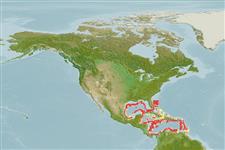ກຸ່ມປາກະດູກອ່ອນ (ເຊັ່ນ: ປາສະຫລາມ, ປາຜາໄລ) (sharks and rays) >
Carcharhiniformes (Ground sharks) >
Pentanchidae (Deepwater catsharks)
Etymology: Apristurus: a-, Latin privative, i.e., without; pristis, from pristes (Gr.), sawyer (but here meaning saw); oura (Gr.), tail, referring to absence of saw-toothed crest of enlarged dermal denticles along upper edge of caudal fin as found in the closely related Pristiurus (=Galeus) (See ETYFish); riveri: In honor of biologist-anthropologist Luis Hugo Howell-Rivero (1899-1986), for his contributions to Cuban ichthyology (this shark described from the north coast of Cuba) (See ETYFish).
Eponymy: Dr Luis Hugo Howell-Rivero (1899–1986) was a Cuban biologist and anthropologist at the University of Havana. [...] (Ref. 128868), visit book page.
Environment: milieu / climate zone / ລະດັບຄວາມເລິກ / distribution range
ນິເວດວິທະຍາ
ສັດທະເລ ກ່ຽວກັບ(ຢູ່)ຊັ້ນນ້ຳໃນທະເລທີ່ເໜີອພື້ນດິນ; ລະດັບຄວາມເລິກ 700 - 1500 m (Ref. 55584). Deep-water; 30°N - 9°N
Western Central Atlantic: Cuba, northern Gulf of Mexico, and Panama.
ຂະໜາດ / ນ້ຳໜັກ / Age
ການຈະເລີນເຕັມໄວ: Lm ? range ? - ? cm
Max length : 46.0 cm TL ຕົວຜູ້/ບໍ່ມີເພດ; (Ref. 244); 41.0 cm TL (female)
Relatively slender, moderately long, narrow snout and relatively narrow, low caudal fin. Color uniform dark brown (Ref. 37039). First to third gill openings long as the distance between the nostrils (Ref. 6032).
Body shape (shape guide): elongated.
Found on the continental slopes. Oviparous, with one egg per oviduct laid at a time. Sexual dimorphism in adults unusually well-developed.
Life cycle and mating behavior
ການຈະເລີນເຕັມໄວ | ການສືບພັນ | ການວາງໄຂ່ | ໄຂ່ | ຄວາມດົກຂອງໄຂ່ປາ | ຕົວອ່ອນ
Oviparous, paired eggs are laid. Embryos feed solely on yolk (Ref. 50449). Sexual dimorphism is evident in dentition of males (Ref. 49562). Males have longer teeth with fewer cusps (Ref. 51093) to make 'courtship biting' more effective (Ref. 49562).
Compagno, L.J.V., 1984. FAO Species Catalogue. Vol. 4. Sharks of the world. An annotated and illustrated catalogue of shark species known to date. Part 2 - Carcharhiniformes. FAO Fish. Synop. 125(4/2):251-655. Rome: FAO. (Ref. 244)
IUCN Red List Status (Ref. 130435: Version 2025-1)
Threat to humans
Harmless
Human uses
ການປະມົງ: ທີ່ບໍ່ມີຄວາມສົນໃຈ
ເຄື່ອງມື
Special reports
Download XML
ແຫຼ່ງອີນເຕີເນັດ
Estimates based on models
Preferred temperature (ເອກະສານອ້າງອີງ
123201): 4.9 - 7.9, mean 5.7 °C (based on 95 cells).
Phylogenetic diversity index (ເອກະສານອ້າງອີງ
82804): PD
50 = 0.5000 [Uniqueness, from 0.5 = low to 2.0 = high].
Bayesian length-weight: a=0.00355 (0.00175 - 0.00721), b=3.08 (2.90 - 3.26), in cm total length, based on LWR estimates for this (Sub)family-body shape (Ref.
93245).
ຊັ້ນເຂດຮ້ອນ (ເອກະສານອ້າງອີງ
69278): 3.9 ±0.6 se; based on size and trophs of closest relatives
ຄວາມຢືດຢຸ່ນ (ເອກະສານອ້າງອີງ
120179): ຕຳ່ຫຼາຍ, ປະຊາກອນຕຳ່ສຸດທີ່ໃຊ້ເວລາສອງເທົ່າຫຼາຍກວ່າ 14 ປີ (Fec assumed to be <10).
Fishing Vulnerability (Ref.
59153): Moderate vulnerability (36 of 100).
🛈
Nutrients (Ref.
124155): Calcium = 10.1 [1.8, 65.5] mg/100g; Iron = 0.358 [0.076, 1.226] mg/100g; Protein = 16.8 [13.6, 19.9] %; Omega3 = 0.225 [0.092, 0.549] g/100g; Selenium = 12.9 [4.1, 41.1] μg/100g; VitaminA = 19.1 [4.1, 92.2] μg/100g; Zinc = 0.379 [0.184, 0.754] mg/100g (wet weight);
